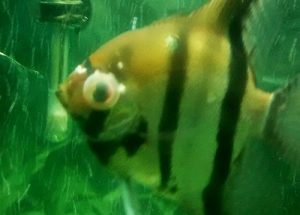Popeye (exophthalmia) is another one of the most common preventable bacterial diseases that occurs with aquarium and pond fish.
Fluid leakage into the area behind the eyeball causes swelling that eventually pushes the eyeball outward. As the pressure builds up and the amount of fluid increases, the more the eyeball of the fish is forced outward. Bacterial infections will usually occur during this stage which left untreated can cause damage to the cornea leading to possible blindness.
PHYSICAL SYMPTOMS:
Popeye is unlikely to be confused with any other fish disease. One or both eyes of the fish become large and look like they are bulging out of the socket (hence the name Pop Eye). As the eye of the fish continue to bulge outwards, the outer surface of the eye may become cloudy or milky white. When only one eye is affected, Popeye is referred to as unilateral. When both eyes are affected, it is called bilateral.
CAUSE:
Bilateral Popeye is most often caused by dirty tanks and continual exposure to chronically poor water quality which is the result of poor maintenance. Internal metabolic system disorders, parasitic infestations, undernourishment, poor diet, vitamin A deficiency, stress, excess lighting, or previous diseases that had infected the fish can also be the cause of full blown Popeye.
Popeye is most common in overcrowded aquariums that do not receive frequent water changes. Not surprisingly, large cichlids, goldfish, and other high waste producing species are where the disease is most often seen.
Unilateral Popeye can be caused by handling injuries, aggression between fish, collisions with objects in the tank, or failed predation attempts.
In both cases poor water quality in the aquarium contributes to Popeye and will need to be improved before the fish can recover.
TREATMENT:
Because Popeye is really three problems; cornea damage, fluid accumulation behind the eyeball, and opportunistic bacterial infections, it is very difficult to treat successfully.
With optimal water quality and a well balanced, vitamin rich diet, minor cornea damage can and usually does improve over time. The swelling behind the eyeball of the fish will also diminish over time, assuming the affected fish is otherwise healthy.
Epsom salt at a dose of 1 to 3 tsp per 5 gallons of water can be used to reduce swelling when used in a quarantine tank. It is not recommended in community aquariums.
Cornea damage can be prevented from turning into full blown Popeye by treating the affected fish with antibiotics or antibacterial medications that are used to treat fin rot.
*Melafix, **Pimafix
, API Fin & Body Cure
, API E.M. Erythromycin
, Tri-Sulfa Tablets, Fish Mox Forte Amoxicillan , KanaPlex, and Methylene Blue
all work but be sure to remove all active carbon from the tank during treatment.
Once full blown Popeye develops, use antibiotics that are formulated specifically against internal and systemic infections. Those administered in food are more effective than those added to the water.
The best treatment for Popeye is KanaPlex in a medicated food mixed in the proportions below with Seachem Garlicguard, and Focus.
- 1 tablespoon fish food (pellets or frozen works best)
- 1 scoop KanaPlex
- 1 scoop Focus
Add enouth water or Garlic Guard and mix thoroughly into a paste. Feed daily for 1 week or until the infection clears. The mixture can be refrigerated or frozen between feeding.
KanaPlex is also very effective when dosed in water column. Use 1 measure per 5 gal and repeat every 48 hours for 3 doses.
PREVENTION:
- Perform regular water changes and testing to prevent bacteria buildup that can lead to Popeye.
- Resist the urge to overcrowd your tank. Fish wastes builds up quickly even with the best of filtration systems.
- Don’t overfeed your fish. Small quantities of quality foods fed two or three times daily is preferable to a single feeding and minimizes waste buildup.
- Only keep compatible species in a community tank environment. Watch new additions for bullying or nipping and separate or remove them when necessary. Watch for changes to eyes, fins, tails, body, appetite, and behavior.
- Quarantine new fish before placing them in a community tank. It is easier to spot and treat fish diseases in a quarantine tank than in a community environment.
*Melafix is a natural wide range antibiotic formulated to heal a wide variety of mild gram positive bacterial infections like tail and fin rot, eye cloud, mouth fungus and more. **Pimafix quickly treats fungal and bacterial infections such as cottony growth, fin and tail rot, etc.



2 Responses to “Popeye”
Trackbacks/Pingbacks
[…] shows up as a secondary infection to Popeye (exophthalmia) and can also lead to […]
[…] INFECTIONS Fin Rot Popeye Cloudy Eye External Infections Fish TB Dropsy Septicemia Swim Bladder Disease Enteric Red […]